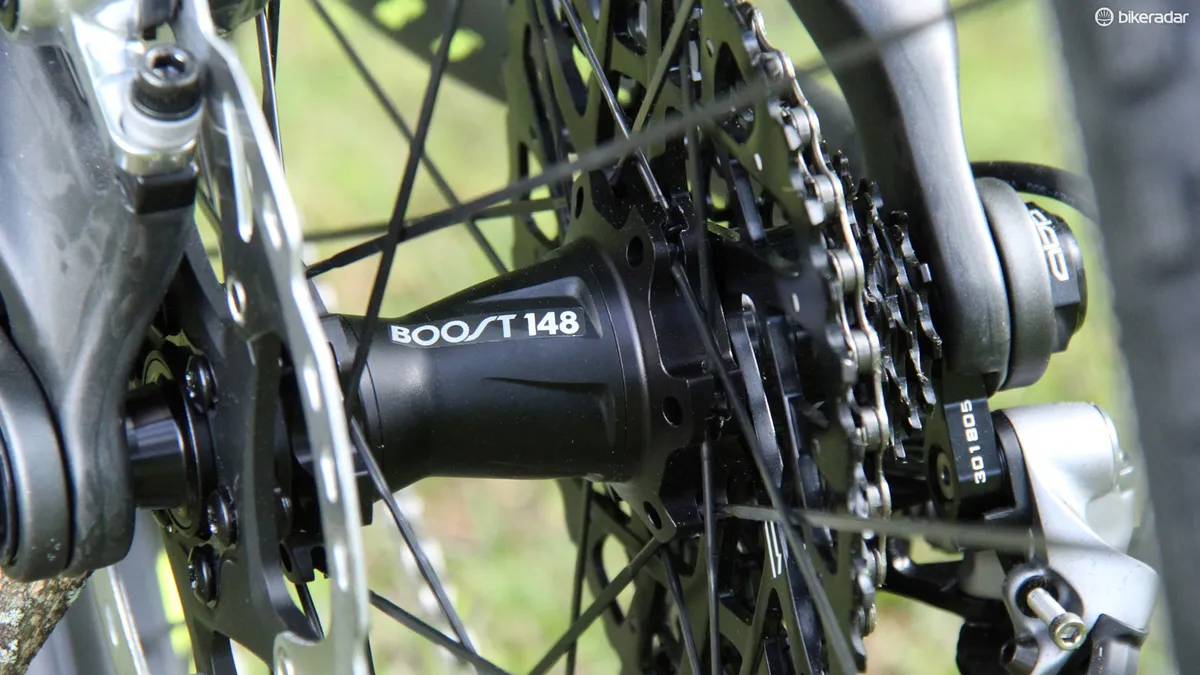For a sport with a reputation of risk-taking, adventure and competitiveness, mountain biking has an oddly conservative streak. And nowhere is this better displayed than the constant rage against new 'standards'. Want stiffer, stronger, lighter and faster bikes? Then dimensions and materials are going to have to change. Some may say 'marketing conspiracy', but I say 'physics'.
When 29in wheels finally caught on, and then 650b emerged in their wake, what was the most common refrain? Was it, "Maybe in a few years, when I buy a new bike, I’ll try one of those"? When wider-spaced hub flanges emerged to make those bigger wheels stiffer, was the reaction, "Yeah, greater triangulation makes obvious sense"?
No. It was a Big Bang of complaining and conspiracy theory, the echoes of which can still be heard on the internet, and the trails, and in the cafes today. You’d think 26in wheels had been forced to stop rotating completely. New standards are, according to some very loud people, nothing but a hateful way for companies to smash open our wallets and make our precious stuff instantly obsolete because, oh God, everything’s getting worse and the whole world’s going to hell and it’s not like it was in the old days.
In fact, the new stuff is often worse than the old… 26 for life! Wake up sheeple, it's a marketing conspiracy.
If you breathe into a paper (or perhaps plastic) bag long enough to calm down and think about it, there’s plenty of evidence for this not being the case. First, though, I need to cover a few bases:
- Yes, marketing exists
- No, not all change is progress
- Yes, they want you to buy more stuff
- No, your existing bike is not obsolete – if it was good yesterday, it’s good today
- Yes, but what are you really angry about?
Nonstandard standards
The biggest real charge that can be levelled against ‘the industry’ is the widespread mistake of calling every new measurement a standard. Created a bottom bracket that’s 3mm wider than all the others? It’s misleading and inaccurate to tell everyone this is a revolutionary new standard. It is, in fact, an awkward new measurement.
Funnily enough, marketing departments don’t fancy printing Awkward New Measurement all over the down tube – not even ANM Technology – so they tend to write something else. They really should stop with the ‘standard’ thing, though.
The biggest false charge that can be levelled against ‘the industry’ is that changing measurements are nothing but a cynical con, or that in fact there’s a meaningful organisation called 'the industry' at all.

There’s a much simpler explanation, and it doesn’t involve secret strategy meetings between thousands of competing companies, military levels of coordination and the ongoing suppression of incriminating evidence.
It’s this. The whole thing is a chaotic shambles. Everybody’s doing their own thing, and can barely get it together to agree how many bolts there should be holding your chainrings on. Then, once these disparate companies have made their great new wheel, shoe, handlebar or whatever, they do their best to convince you that theirs is best… with marketing. Surprise!
And yet ultimately, you decide if it works. You. Me. All of us.
No (Dual) Control
Look what happened with Shimano’s Dual Control levers in the early 2000s. These combined braking and shifting on a single lever, and were supposed to be the next big thing. However, Dual Control really could force you to buy something you didn’t want, because you had to have both Shimano brakes and drivetrain. And the company was looking to make all its brakes/shifters this way. Hmmm.
So a lot of people spent their money elsewhere, and Dual Control failed. Even a company as dominant as Shimano couldn’t make a better alternative (being able to mix and match) go obsolete. Not much of a conspiracy, then.
So why the continued hysteria and cynicism about new products, and whether they should even exist, or are actually inferior to the old one?
For a start there’s confirmation bias, which is a tendency to filter information so it maintains your pre-existing belief. Having invested heavily in one thing – say a mountain bike of certain dimensions – some people will overstate anything positive and dismiss anything critical, in order to keep alive the belief that it’s best.
If a mountain bike with new dimensions appears it’s inherently critical, as it implies the first one is ‘wrong’… at least, it does if you’re weirdly absolutist about it, and not a little bit paranoid, and the mere thought of other people beating you gives you the fear.

Humans also show a measurable bias towards information that’s earlier in a sequence, even when the sequence itself is not relevant. For some, an earlier truth feels more true, just for existing earlier. It’s so insidious, the effect can continue even after it’s proved wrong.
Ignoring the evidence
It’s a genuinely meaningful thing, even in some very serious circumstances. For instance, all the early evidence again David Camm in the September 2000 murder of his family was shown to be either inaccurate or unreliable, but the Indiana cops had already decided. A sweatshirt found at the scene bore the DNA, prison nickname and Department of Corrections number of a man called Charles Boney, whose previous crimes bore similarities, yet Boney was ignored. The cops only tested the sweatshirt for Camm’s DNA, because they 'knew' it was him. And perhaps they never read the label. Camm was not just tried, but convicted.
When the 'foreign' DNA was finally tested five years later, did the cops finally admit they were wrong? No. Camm was re-convicted as an accessory, despite the men having no link. Camm was only acquitted and released in 2013. The cops are probably still convinced he did it.
If confirmation bias can get extreme enough to put an innocent man in prison – twice – you can be sure it can fuel an insistence that somebody’s bike is the best no matter what gets invented afterwards.
Of course maybe I’m wrong. New designs such as Boost axle spacing, plus-sized wheels and 12-speed are marketing BS, and I’ve fallen for it. And for everything else. But as the alternative is bikes that don’t change at all (while prices go up because labour, distribution and marketing costs increase regardless), I’m okay with that.
We used to have quill stems, square-taper cranks, 7-speed blocks, rim brakes, bolted seatposts, wire axles and road bike geometry. I, for one, am pleased that next year’s bikes will be covered in Awkward New Measurement Technology.
